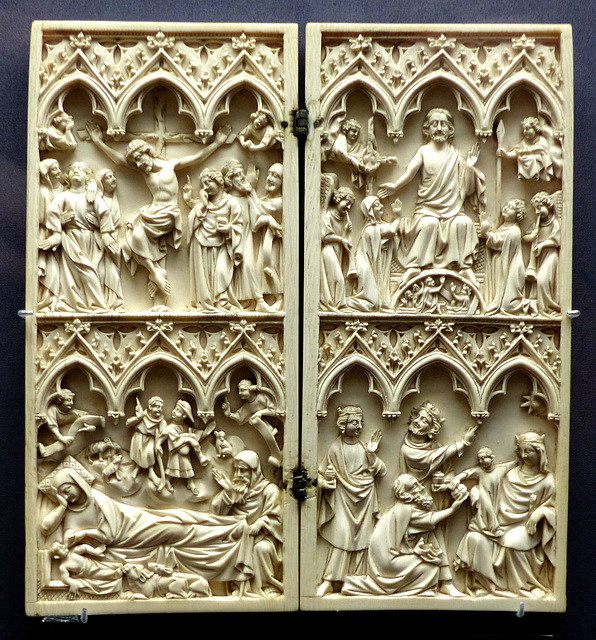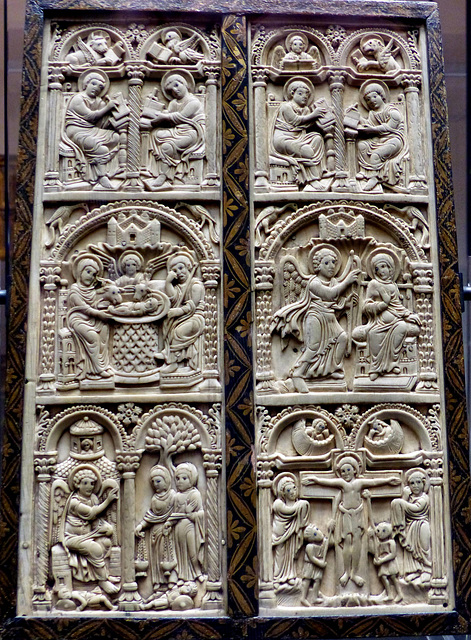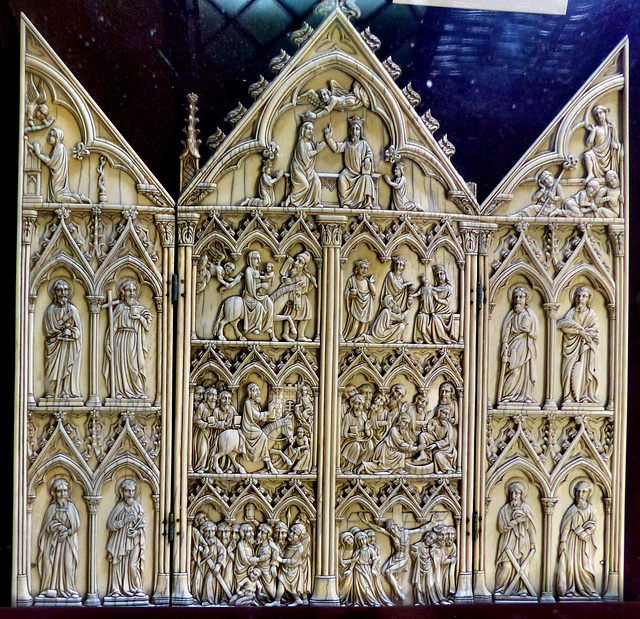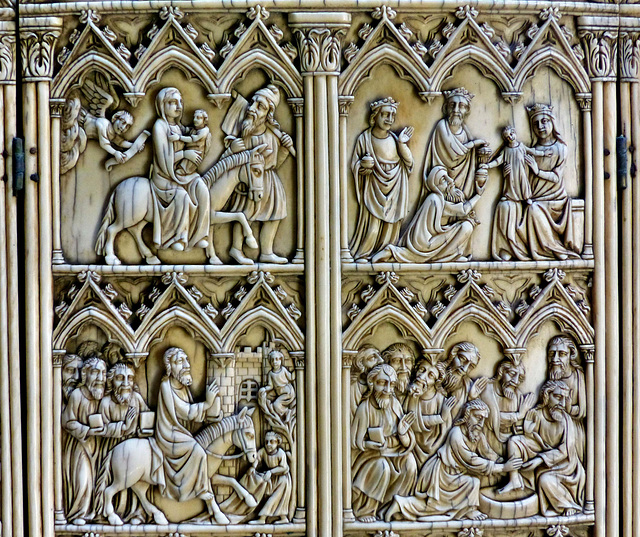
Ivory
Cologne - KOLUMBA
KOLUMBA is the art museum of the Archdiocese of Cologne, originally founded in 1853. During WWII the museum´s collection got evacuated and was saved. Upto 2007 the museum was located near the cathedral. The site of the muesum´s new home was occupied by the Church of St. Columba, which was destroyed in WWII. The new award winning structure designed by Swiss architect Peter Zumthor, built for the museum now shares its site with the ruins of the Gothic church.
The museum is known for very interesting exhibitions, that are altered several times over the year displaying the own collection in changing contexts.
12th century ivory crucifix (detail) - (see prev. upload)
www.kolumba.de/?language=eng
Cologne - Schnütgen Museum
Cologne is the fourth-largest city in Germany - and one of the oldest. A Germanic tribe, the Ubii, had a settlement here, this was named by the Romans "Oppidum Ubiorum". In 50 AD, the Romans founded "Colonia Claudia Ara Agrippinensium", the city then became the provincial capital of "Germania Inferior".
A city with such a history has -of course- many museums. One is the "Museum Schnütgen", devoted to medieval art. In 1906, the collection of Alexander Schnütgen, a theologian and passionate art collector, was donated to the city.
Since 1956, the museum has occupied the Romanesque church of St. Cäcilien (1130-1160), that was once part of a monastery founded in 881. An annex was added in the 1950s, but even now only about 10% of all artefacts can be displayed as of course the collection has expanded since Schnütgen´s donation.
www.museum-schnuetgen.de/Info
The Nativity of Christ.
Carved from walfus ivory 1150/1160 in Cologne.
Cologne - Schnütgen Museum
Cologne is the fourth-largest city in Germany - and one of the oldest. A Germanic tribe, the Ubii, had a settlement here, this was named by the Romans "Oppidum Ubiorum". In 50 AD, the Romans founded "Colonia Claudia Ara Agrippinensium", the city then became the provincial capital of "Germania Inferior".
A city with such a history has -of course- many museums. One is the "Museum Schnütgen", devoted to medieval art. In 1906, the collection of Alexander Schnütgen, a theologian and passionate art collector, was donated to the city.
Since 1956, the museum has occupied the Romanesque church of St. Cäcilien (1130-1160), that was once part of a monastery founded in 881. An annex was added in the 1950s, but even now only about 10% of all artefacts can be displayed as of course the collection has expanded since Schnütgen´s donation.
www.museum-schnuetgen.de/Info
Diptych with the Nativity, the Adoration of the Magi, the Crucifixion and the Last Judgment. Carved from ivory 1350/1370 in Cologne or Paris.
Cologne - Schnütgen Museum
Cologne is the fourth-largest city in Germany - and one of the oldest. A Germanic tribe, the Ubii, had a settlement here, this was named by the Romans "Oppidum Ubiorum". In 50 AD, the Romans founded "Colonia Claudia Ara Agrippinensium", the city then became the provincial capital of "Germania Inferior".
A city with such a history has -of course- many museums. One is the "Museum Schnütgen", devoted to medieval art. In 1906, the collection of Alexander Schnütgen, a theologian and passionate art collector, was donated to the city.
Since 1956, the museum has occupied the Romanesque church of St. Cäcilien (1130-1160), that was once part of a monastery founded in 881. An annex was added in the 1950s, but even now only about 10% of all artefacts can be displayed as of course the collection has expanded since Schnütgen´s donation.
www.museum-schnuetgen.de/Info
The so called "Harrach Diptych" from the Court School of Charlemagne (~800). Carved from ivory.
Tongeren - Onze-Lieve-Vrouwebasiliek
Tongeren, founded 15BC under the name of "Aduatuca Tungrorum", is the oldest town in Belgium. The Romans set up a military camp, that was later abandoned, - but the settlement, that had grown around the camp developed into an important trading center near the Roman road linking Colonia Claudia Ara Agrippinensium (Cologne) to Bononia (Boulogne-sur-Mer). Though strongly fortified the Franks sacked the town in 275.
The Roman reign endet when the town got destroyed in 451 probably by the Huns. At that time a seat of a bishop existed here already. This see later moved on to Maastricht (595) and finally to Liege (718). In 881 Tongeren was raided and looted by the Normans. The largely destroyed city was rebuilt in the 10th century.
Tongeren prospered but in 1677 Louis XIV’s troops blew up the city walls and burned the town down. It took the town two centuries to recover from this.
Where the Onze-Lieve-Vrouwebasiliek stands now, was the bishopric see with Saint Maternus and Saint Servatius, the first bishops of the diocese founded here. In Carolingian times a collegiate convent existed and a pre-Romanesque church was erected, that later got replaced by a Romanesque structure. This church burned down during a war, fought by the prince-bishop of Liège, the Count of Loon, the Duke of Brabant and the French King.
Following the complete demolition of the burnt church, the construction of the large-scale gothic collegiate and town church began in 1240. It was completed in its present form in the 16th century.
Since some years the basilica´s treasures are displayed in the "Teseum", a museum, located in the building of the former collegiate, that adjoins the church.
A very elaborated ivory carving, that may have been carved in Northern Italy within the 11th century. There was a second "wing", that is now kept in a Brussels´ museum.
teseum.be/en/
Tongeren - Onze-Lieve-Vrouwebasiliek
Tongeren, founded 15BC under the name of "Aduatuca Tungrorum", is the oldest town in Belgium. The Romans set up a military camp, that was later abandoned, - but the settlement, that had grown around the camp developed into an important trading center near the Roman road linking Colonia Claudia Ara Agrippinensium (Cologne) to Bononia (Boulogne-sur-Mer). Though strongly fortified the Franks sacked the town in 275.
The Roman reign endet when the town got destroyed in 451 probably by the Huns. At that time a seat of a bishop existed here already. This see later moved on to Maastricht (595) and finally to Liege (718). In 881 Tongeren was raided and looted by the Normans. The largely destroyed city was rebuilt in the 10th century.
Tongeren prospered but in 1677 Louis XIV’s troops blew up the city walls and burned the town down. It took the town two centuries to recover from this.
Where the Onze-Lieve-Vrouwebasiliek stands now, was the bishopric see with Saint Maternus and Saint Servatius, the first bishops of the diocese founded here. In Carolingian times a collegiate convent existed and a pre-Romanesque church was erected, that later got replaced by a Romanesque structure. This church burned down during a war, fought by the prince-bishop of Liège, the Count of Loon, the Duke of Brabant and the French King.
Following the complete demolition of the burnt church, the construction of the large-scale gothic collegiate and town church began in 1240. It was completed in its present form in the 16th century.
Since some years the basilica´s treasures are displayed in the "Teseum", a museum, located in the building of the former collegiate, that adjoins the church.
The book cover was created within the 12th century, but the ivory plate in the center, depicting the crucifixion, was carved already around 1000. On the bottom of the plate are the personifications of "Earth" (left) and "Sea" or "Water" (right), while "Sun" and "Moon" are on the top.
teseum.be/en/
Palermo - Elephant
Sicily, the largest Mediterranean island, has a long history, that starts around 8000 BC, but later there were Phoenician, Carthaginian, Greek and Roman periods. After the Roman Empire had fallen apart the Vandals tried to take over the island but failed. Finally, the Ostrogoths took possession.
Mid of the 6th century Sicily was conquered by troops of the Byzantine Empire. After the advent of Islam, Sicily got attacked by the Arab forces. Raids seeking loot continued until the mid-8th century.
A Muslim army was sent to the island in 827 but met with much resistance. So it took a century to conquer it and even later revolts constantly occurred
In 1038 the Byzantines invaded the island supported by Norman mercenaries, led by Roger. In 1072, after the siege of Palermo, most of Sicily was under Norman control. Roger´s son Roger II raised the status of the island to a kingdom in 1130. During this period, the Kingdom of Sicily was prosperous and powerful,
The court of Roger II became melting out of culture from Europe and the Middle East. This attracted scholars, scientists, artists, and artisans. Muslims, Jews, Greeks, Lombards, and Normans cooperated and created some extraordinary buildings.
In 1186 the last descendant of Roger, Constance of Sicily married Emperor Henry VI, the second son of Barbarossa. So the crown of Sicily was passed on to the Hohenstaufen Dynasty. Frederick II, the only son of Constance, was crowned King of Sicily at the age of four in 1198. He became "Stupor Mundi", one of the greatest and most cultured men of the Middle Ages.
Palermo, founded in 734 BC by the Phoenicians, became a possession of Carthage and later was part of the Roman Empire. From 831 to 1072 the city was under Arab rule. Following the Norman conquest, Palermo became the capital of a new Kingdom of Sicily and the capital of the Holy Roman Empire under Emperor Frederick II and King Conrad IV.
Today Palermo is a bustling city with a population of about 700.000 plus - many many tourists.
This is the lid of an ivory box, that is on display at the museum inside the "Palazzo dei Normanni". It is absolutely prohibited to take any photos there - and there are quite a lot of warders, who not only warn the visitors. Normally I strictly obey such rules, but when I noticed the elephant, I just had to take a shot. Some of you will know, that I do have a special interest in "Medieval Elephants" - and this one is pretty precise!
I have the impression, that the box was produced in the 11th/12th century. I case it is younger, then this must be the Cremona elephant, a gift presented to Frederick II by Sultan of Egypt Al-Kamil in 1229.
Maybe the falconer gives a hint to Frederick II.
Auxerre - Cathédrale Saint-Étienne
The Cathédrale Saint-Étienne seen today is actually the 5th on the spot.
The erection started in 1215 around the same time, when the building of the cathedrals in Reims and Amiens started. The choir was completed in 1235. The stained glass of the choir windows was created until 1250. The same time, the construction of the facade began. Around 1300, construction began on the southern arm of the transept.
The sculptured portal is dated to around 1320. The nave was built from around 1320–1350, but the Hundred Years' War slowed the work down and delayed the completion of the south aisle until 1378. The north transept and the towers had not begun at the beginning of the 15th century. In 1478, the nave was vaulted and in 1500 work on the north tower began and was completed after 43 years. The south tower was never completed.
Though looted a couple of times, the cathedral has precious works of art in the treasury. A delicate triptych, carved from ivory within the 14th century.
Auxerre - Cathédrale Saint-Étienne
The Cathédrale Saint-Étienne seen today is actually the 5th on the spot.
The erection started in 1215 around the same time, when the building of the cathedrals in Reims and Amiens started. The choir was completed in 1235. The stained glass of the choir windows was created until 1250. The same time, the construction of the facade began. Around 1300, construction began on the southern arm of the transept.
The sculptured portal is dated to around 1320. The nave was built from around 1320–1350, but the Hundred Years' War slowed the work down and delayed the completion of the south aisle until 1378. The north transept and the towers had not begun at the beginning of the 15th century. In 1478, the nave was vaulted and in 1500 work on the north tower began and was completed after 43 years. The south tower was never completed.
Though looted a couple of times, the cathedral has precious works of art in the treasury. Four biblical episodes carved from ivory within the 14th century.
Jump to top
RSS feed- Latest items - Subscribe to the latest items added to this album
- ipernity © 2007-2024
- Help & Contact
|
Club news
|
About ipernity
|
History |
ipernity Club & Prices |
Guide of good conduct
Donate | Group guidelines | Privacy policy | Terms of use | Statutes | In memoria -
Facebook
Twitter










